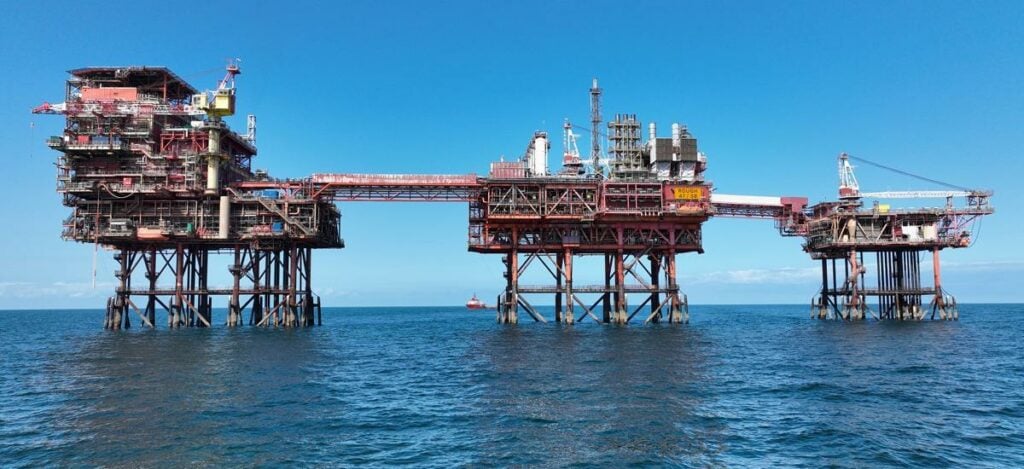Centrica has officially reopened the Rough gas storage facility, increasing the UK’s storage capacity by 50%.
It gained consent from the North Sea Transition Authority in August to reopen the site situated off the East Yorkshire coast. It subsequently undertook significant engineering upgrades over the summer, ahead of commissioning the site in the Autumn.
The company has now made the first injection of gas into the site in over five years, thanks to an initial investment programme.
Rough was closed in 2017 following tests prompted by an issue affecting the maximum operating pressure of the Rough wells. Centrica Storage Limited announced that the site had come to the end of its design-life following these issues. This was an assessment backed by the Competition & Markets Authority, with significant upgrades required to keep it running.
At the time, it was deemed that LNG imports had reduced the economic rationale of having such a site in the UK, although concerns were raised even then that it would lead to energy insecurity over coming winter periods.
As such, after operating for 32 years, the decision was made to shut the Rough gas storage site.
Given the current energy crisis – driven by record high gas prices – the site has now been reopened and is in the position to store up to 30 billion cubic feet (bcf) of gas over the coming winter.
“I’m delighted that we have managed to return Rough to storage operations for this winter following a substantial investment in engineering modifications,” said Centrica Group chief executive, Chris O’Shea.
“Our long-term aim remains to turn the Rough field into the world’s biggest methane and hydrogen storage facility, bolstering the UK’s energy security, delivering a net zero electricity system by 2035, decarbonising the UK’s industrial clusters, such as the Humber region by 2040, and helping the UK economy by returning to being a net exporter of energy.”
The work done on Rough means that it can operate at around 20% of its previous capacity this winter, making it the largest gas storage site in the UK again. When gas prices are low, gas will be injected into the site and utilised when demand is higher.
“In the short term we think Rough can help our energy system by storing natural gas when there is a surplus and producing this gas when the country needs it during cold snaps and peak demand. Rough is not a silver bullet for energy security, but it is a key part of a range of steps which can be taken to help the UK this winter,” added O’Shea.
While the UK has diverse gas suppliers – which has put it in a relatively strong position in recent months, adding to its role as a net exporter of power over the past two quarters – it still has some of the lowest levels of gas storage in Europe.
With Rough reopening, the UK still only has nine days of storage, while Germany has 89 day, France 103 days and the Netherlands 123.
|
Name |
Gas in storage (TWh) |
Full (%) |
Consumption (TWh) |
|
EU |
1047.202 |
93.93 |
3776.434 |
|
Germany |
239.9013 |
97.82 |
905.3031 |
|
Italy |
183.8766 |
95.05 |
725.0259 |
|
France |
132.1973 |
99.69 |
430.4139 |
|
Netherlands |
127.474 |
91.71 |
350.6667 |
|
Non-EU |
113.951 |
34.02 |
1030.527 |
|
Ukraine |
103.4391 |
31.81 |
261.0519 |
|
Austria |
86.7086 |
90.75 |
90.1387 |
|
Hungary |
56.479 |
83.42 |
107.8658 |
|
Czech Republic |
40.5146 |
92.55 |
90.6943 |
|
Poland |
35.6508 |
97.91 |
232.4541 |
|
Slovakia |
34.8348 |
92.04 |
53.2106 |
|
Spain |
33.1129 |
93.94 |
338.9865 |
|
Romania |
31.1076 |
94.86 |
114.3571 |
|
Latvia |
13.6137 |
56.55 |
11.5885 |
|
United Kingdom (Post-Brexit) |
10.5118 |
100 |
769.4755 |
Credit: AGSI.
Gas storage across Europe nearing capacity has helped lower prices over the last couple of weeks, along with the exceptionally mild October keeping demand low. This has led to relative stability both in Britain and on the Continent, as explained in the most recent edition of our Current± Price Watch series.
In the long-term, Centrica is still planning to turn Rough into the largest long duration energy storage facility in Europe, it said, capable of storing both natural gas and hydrogen.
The potential of hydrogen for longer term storage is being considered by a number of companies around the world, as the transition to net zero necessitates increased flexibility to capitalise on cheap, green but variable renewables.
This includes a number of hydrogen projects awarded funding in February as part of the Longer Duration Energy Storage Demonstration Programme.





